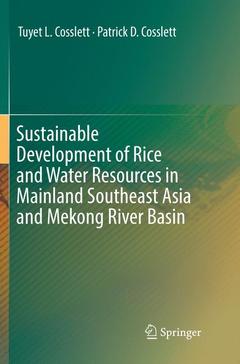Description
Sustainable Development of Rice and Water Resources in Mainland Southeast Asia and Mekong River Basin, Softcover reprint of the original 1st ed. 2018
Authors: Cosslett Tuyet L., Cosslett Patrick D.
Language: English
Subjects for Sustainable Development of Rice and Water Resources in...:
Keywords
Rice cultivation; Mekong river water; Climate change; Mekong mainstream dams; Regional cooperation; Rice production; Food security; Water security; Xayaburi dam; Don Sahong dam; Mekong River Commission; Lower Mekong Basin; Rice consumption; Rice trade; Mekong cooperation frameworks; Greater Mekong Subregion; Lower Mekong Initiative; Mekong-Japan Summit; Lancang-Mekong Cooperation Mechanism; Paddy land; sustainability
Approximative price 84.39 €
In Print (Delivery period: 15 days).
Add to cartPublication date: 01-2019
Support: Print on demand
Approximative price 105.49 €
In Print (Delivery period: 15 days).
Add to cartPublication date: 10-2017
Support: Print on demand
Description
/li>Contents
/li>Biography
/li>Comment
/li>
This book highlights rice and water resources security in Cambodia, Laos, Thailand, and Vietnam ? countries that share the international Mekong River, which is a source of both regional cooperation and conflict. It discusses the topography, population, economy, rice production and rice trade of these four riparian countries, and analyses the impacts of climate change, El Nino and La Nina, and the construction of Mekong mainstream dams on water resources and rice productivity. Further, this publication assesses the role of the Mekong River Commission, a river basin organization responsible for the sustainable development and water resource management of the Mekong, and examines regional cooperation frameworks such as the Lower Mekong Initiative, and the Mekong-Japan Summit. The book then explores the emerging role of China in promoting the Lancang-Mekong cooperation between China and Myanmar, Cambodia, Laos, Thailand, and Vietnam in developing the Mekong River Basin, which could determine the future water and rice security of the region.
Introduction
1. The Setting of the Lower Mekong Countries
1.1 Topography
1.1.1 Cambodia
1.1.2 Laos
1.1.3 Thailand
1.1.4 Vietnam
1.2 Population
1.2.1 Cambodia
1.2.2 Laos
1.2.3 Thailand
1.2.4 Vietnam
1.3 Workforce
1.3.1 Cambodia1.3.2 Laos
1.3.3 Thailand
1.3.4 Vietnam
1.4 Economy
1.4.1 Cambodia
1.4.2 Laos
1.4.3 Thailand
1.4.4 Vietnam
References
2. Rice Cultivation, Production, and Consumption in the Lower Mekong Countries
2.1 Rice Cultivation
2.1.1 Cambodia
2.1.2 Laos
2.1.3 Thailand
2.1.4 Vietnam
2.2 Rice Production
2.2.1 Cambodia
< 2.2.2 Laos
2.2.3 Thailand
2.2.4 Vietnam
2.3 Rice Consumption
2.3.1 Cambodia
2.3.2 Laos
2.3.3 Thailand
2.3.4 Vietnam
2.4 Conclusion
References
3. Rice trade in the Lower Mekong Countries
3.1 Background of rice exports of Thailand, Vietnam, and Cambodia 1855-1999 <
3.1.1 Thailand
3.1.2 Vietnam
3.1.3 Cambodia
3.2 Policies of rice export of the LMCs in the new millennium
3.2.1 Thailand
3.2.2 Vietnam
3.2.3 Cambodia3.2.4 Laos
3.3 Performance of rice exports of Thailand, Vietnam, and Cambodia in 2000-2014
3.3.1 LMCs rice export and World rice export
3.3.2 LMCs rice export relative to milled rice production
3.4 Rice trade of the LMCs 2000-2014
3.4.1 Thailand
3.4.2 Vietnam
3.4.3 Cambodia
3.4.4 Laos3.5 Rice across border trade of the LMCs
3.5.1 Cambodia border trade with Vietnam and Thailand
3.5.2 Laos border trade with Vietnam, Thailand, and China
3.5.3 Thailand border trade with Burma and China
3.5.4 Vietnam border trade with Cambodia, Laos, and China
3.6 Conclusion
References
4.Lower Mekong Basin: Rice production, Climate change, ENSO, Mekong Dams
4.1 Lower Mekong Basin setting
4.1.1 Topography
4.1.2 Population
4.1.3 Economy
4.2 Agricultural land, farming, and rice production
4.2.1 Agricultural land and farming
4.2.2 Rice production
4.3 Climate change, floods and droughts, and El Nino Southern Oscillation (ENSO)4.3.1 Assessment of climate change
4.3.2 Impact of floods and droughts in the Lower Mekong Basin
4.3.3 Impact of El Nino and La Nina of the ENSO cycle (2001-2016) <
4.4 Mekong mainstream dams
4.4.1 Mekong mainstream dams in China
4.4.2 Impacts of Chinese dams in the Lower Mekong Basin
4.5 Conclusion
References
5. Mekong Regional Cooperation for Water Resources and Rice Security
5.1 Mekong River Commission
5.1.1 MRC structure
5.1.2 Basin development strategy
5.1.3 Agriculture and irrigation programs
5.1.4 Rules of Procedure for water utilization and diversion
5.2 Lower Mekong Mainstream Dams5.2.1 Proposed mainstream dams in Lower Mekong Basin
5.2.2 MRC review of Xayaburi dam project
5.2.3 MRC review of Don Sahong dam project
5.2.4 Studies on impacts of the Lower Mekong River mainstream dams
5.2.5 Assessment of the Mekong River Commission
5.3 Rice regional cooperation proposals and competition
5.3.1 Rice regional cooperation proposals
5.3.2 Rice regional competition
5.4 China’s Lancang-Mekong Cooperation Mechanism
5.3.1 China initiative, purpose and programs
5.3.2 Sanya Declaration
5.5 Conclusion
References
6. Conclusion
Ms. Tuyet L. Cosslett
VA, USA
Mr. Patrick D. Cosslett
VA, USAExamines how climate change creates uncertainty regarding the continued supply of water to paddy cultivation
Provides detailed analyses of the paddy land and farming, rice production policies, consumption, and trade in the four countries
Assesses the Mekong River Commission’s role in promoting regional cooperation in developing and managing the water resources of the Lower Mekong Basin under the threats of climate change and mainstream dams
Discusses the Lancang-Mekong Cooperation mechanism and the new chapter of political, social, and economic change in the region, including the sustainable development of water resources and rice security
These books may interest you

China’s Hydro-politics in the MekongConflict and Cooperation in Light of Securitization Theory 178.41 €



